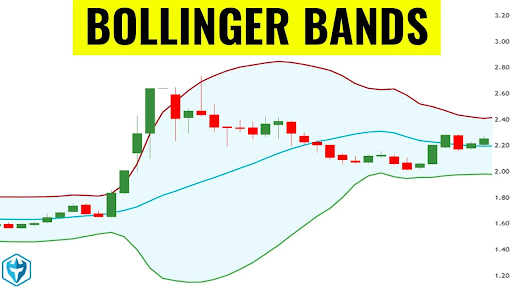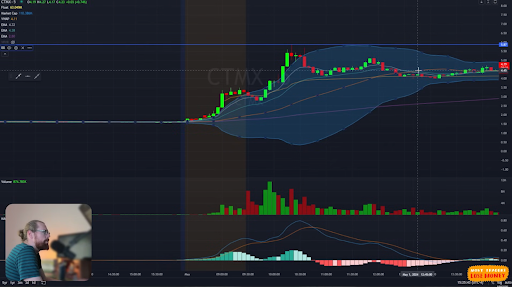- What Are Bollinger Bands?
- How I Use Bollinger Bands in Day Trading
- Price Outside the Bands = Reversal Risk
- Don’t Act on the First Candle — Wait for Confirmation
- Why I Pair Bollinger Bands With the 9 EMA
- Live Trade Example: CTMX & P Stock
- When Not To Use Bollinger Bands
- My Favorite Indicators To Pair With Bollinger Bands
- Final Thoughts: Mastering the Bollinger Bands Strategy
Watch Full Video Here: Bollinger Bands: Why Millionaire Traders Are Using This Technical Indicator
When I first started using Bollinger Bands, I realized they were more than just lines on a chart. These bands — simple as they look — can give you a powerful edge in reading price action, especially when you know what to look for.
In this article, I’m breaking down exactly how I use the Bollinger Bands strategy in my day trading, how I combine them with other indicators, and the specific signals I look for when a reversal is coming.
Let’s dive in.
What Are Bollinger Bands?
Bollinger Bands are a type of technical indicator that helps visualize volatility. They’re made up of three components: a simple moving average in the middle (usually a 20-period SMA), and two bands above and below that line, placed at a standard deviation (typically 2). The outer bands expand and contract based on price volatility.
I keep the default settings. If you tweak them too much, you’re not seeing what other traders are seeing, and that’s a problem. In this business, I want to be reacting to what the majority is watching. If you change them from what everyone else is using, you’re going to see different buy and sell signals.
So, default settings. Always.
How I Use Bollinger Bands in Day Trading
This indicator isn’t something I rely on by itself. But when I combine it with price action, volume, and a couple of other indicators, it becomes incredibly useful, especially for spotting reversals.
Price Outside the Bands = Reversal Risk
Whenever I see a candle fully outside the upper or lower Bollinger Band, that’s my first signal. It’s not a guarantee, but it tells me we’re stretched.
Nearly 95% of the price action during the day will occur inside the Bollinger bands. So when we’re outside, that’s a sign we’re reaching an extreme.
That’s when I start preparing for a possible reversal. But — and this is important — I don’t act on the first candle alone.
Don’t Act on the First Candle — Wait for Confirmation
Just because a candle is outside the band doesn’t mean I’m jumping in. What I look for next is confirmation: usually a topping tail, a doji, or a candle with a small body and a long wick. The actual entry happens on the next candle when it breaks the low of that signal bar.
Your stop? It’s always at the high of the day.
The best setups have that clear structure. The confirmation is then when the next candle breaks the low and your stop is always at the high of day.
Why I Pair Bollinger Bands With the 9 EMA
I rarely trade off Bollinger Bands alone. One of the best companion indicators is the 9 EMA. If the price is extended outside the Bollinger Bands and it’s well off the 9 EMA, that’s a red flag for overextension.
When price is extended off the 9 EMA and outside the bands, I’m watching for the rug to get pulled. It increases the odds of a false breakout, especially when the MACD is starting to curl against the move.
Live Trade Example: CTMX & P Stock
Let me show you how this played out with a couple of stocks I watched and traded recently: CTMX and ticker P.
CTMX was up about 200% on the news. We saw a strong move, a small pullback, and then another push higher. Then came the topping tail candle — fully outside the upper band. The volume was high, the MACD was curling, and we were way above the 9 EMA.
That was my cue.
Same thing with P. We got an initial breakout, and then the next candle was red and completely outside the bands. That told me a pullback was likely. And sure enough, it came back to the 9 EMA, then to the 20 EMA, and eventually to VWAP.
It’s about recognizing when we’re extended and knowing that most of the time, we’ll snap back like a stretched rubber band.
When Not To Use Bollinger Bands
There are situations where Bollinger Bands aren’t all that helpful. Here’s when I typically avoid using them:
- Bands are too compressed: When the upper and lower bands are tight, it usually means the stock is in a consolidation phase. That can lead to choppy, sideways movement, and I don’t want to get caught in a fake breakout.
- Low volume: I f there’s no volume behind the move, I don’t trust the setup. Volume is key for confirming price action.
- MACD is flat or curling against you: If momentum isn’t lining up, that’s a big red flag.
- Too many indicators on your chart: This one’s a big deal. If you overload your screen with 10+ indicators, it becomes hard to see what really matters. That’s how you fall into analysis paralysis.
If you have 25 indicators that you have to review every time before you take a trade, you’re going to start getting conflicting signals.
Keep it clean. Keep it simple.
My Favorite Indicators To Pair With Bollinger Bands
If you’ve watched my videos, you know I like clean charts. Here’s what I use with Bollinger Bands:
- 9 EMA: short-term support/resistance
- 20 EMA: second layer of confirmation
- MACD: shows momentum shifts and crossovers
- VWAP: helps me gauge overall strength or weakness
- Candlestick patterns: especially dojis and topping tails
You don’t need a hundred indicators — I trade with 4 or 5, max.
Final Thoughts: Mastering the Bollinger Bands Strategy
To get good with Bollinger Bands, you need to watch how price behaves around them in real time. Focus on reversals when candles stretch outside the bands. Look for confirmation. Pair them with the 9 EMA and MACD.
And don’t overcomplicate your charts. The best traders keep it clean and trust what the indicators — and volume — are telling them.
The more screen time you log, the more second nature this all becomes.
If you want to dive deeper into strategies like this, check out my live trading classes and tools at Warrior Trading — that’s where I teach it all in real time.




